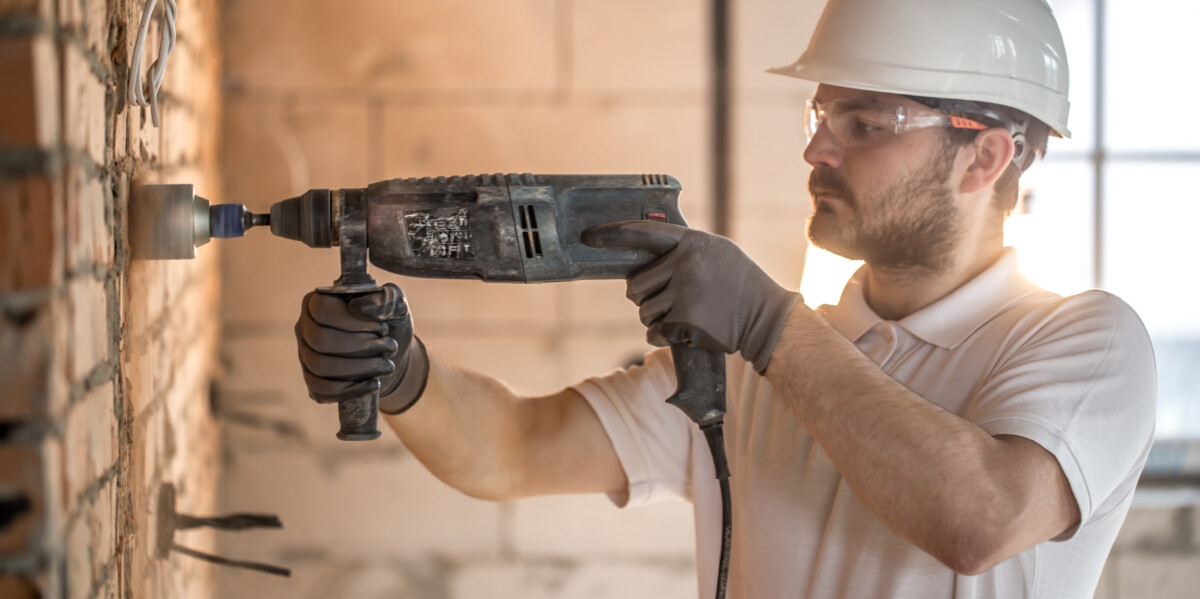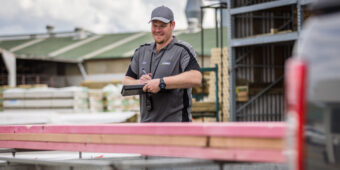HAVS and have nots – a cautionary tale
25 Jan 2022, LBP & Regulation, Learn, Prove Your Know How

Repeated vibrations from power and hand tools can cause Hand Arm Vibration Syndrome (HAVS), a dangerous condition that can be permanently disabling
When Jason Johnstone was medically discharged from his job as an operator/trainer after being diagnosed with HAVS, he decided to explore ways to prevent it happening to other New Zealanders.
Jason is one of the few people in New Zealand diagnosed with HAVS, a condition where nerves and blood vessels are damaged by exposure to repeated vibrations from hand and power tools. It can be permanently disabling. Symptoms include tingling fingers, numbness, pain, weakness, loss of dexterity and impeded blood flow.
If caught early enough, HAVS can be reversible – but, in Jason’s case, his symptoms persist, flaring up at the slightest change in temperature or during certain activities.
“All the crockery in our house has chips on it because, when I do the dishes, my fingers often go numb and I tend to drop them. It’s much worse in winter and I’m pretty much stuffed when it comes to doing up buttons.”
Bad vibrations
Jason has worked with power tools for most of his life. His HAVS symptoms became more pronounced while he was working at the Tiwai Point aluminium smelter as an operator/trainer — a job that involved use of tools such as jack hammers. The smelter did have time limits on use of certain tools, but it turns out intensity was also a factor.
“My wife is a UK-trained general surgical registrar and diagnosed me with HAVS, though I had no idea what HAVS was at that time. I told the smelter doctor my hands felt funny and was sent to see occupational health specialist Professor David McBride, a leading workplace disease expert in New Zealand, who formally diagnosed me.
“Basically, I was told l couldn’t use the tools anymore and was medically discharged from my job at Tiwai. But, what I noticed was that no one had any idea how the injury had occurred. Sure, vibration emitted from tools and machinery had caused my injury but there was no data to explain this to the medical or health and safety professional. No one knew how much vibration I had been exposed to on a daily basis, nothing. It was all guesswork and seemed completely crazy, felt like I had wasted 20 years of my life.”
Potential misdiagnosis
Jason’s experience led him to research current figures on HAVS in New Zealand, revealing what he sees as a major issue of underdiagnosis and misdiagnosis.
“According to ACC data on HAVS, there were only 40-50 cases of HAVS in New Zealand from 2000-2018,” says Jason. “This seems unusual, because 6,230 cases were reported in the UK in half of that time. Assuming the workforces are similar, based on population statistics, New Zealand should have witnessed 785 cases in 14 years, or around 44 cases per year.”
He also found that, between 1 July 2009 and 30 June 2019, ACC data showed there were 5,342 cases of carpal tunnel syndrome compared to the United Kingdom’s 2,930. Furthermore, international research has shown that vibration from hand tools does contribute to carpal tunnel injuries.
“In the UK, doctors are trained to recognise HAVS. In New Zealand, they’re not. So, it’s very often misdiagnosed as carpal tunnel and that certainly has been my experience. I believe it’s a problem in New Zealand given workers’ exposure in our construction, forestry, manufacture, transport and agriculture sectors.”
Jason identified the need for a user-based device to monitor vibration and capture much-needed data. He worked with software developer Digital Stock in Invercargill to develop a HAVS monitoring app and dashboard – and sought a real workplace in which to trial it.
Good fit
The ‘real’ workplace Jason found was Delta, a Dunedin-based infrastructure maintenance company that services electricity distribution and communications networks as well as maintaining the local authority’s green spaces. Delta had recently identified HAVS as a workplace hazard for its employees who often use vibrating machinery such as mowers and weed eaters for long periods.
As a result, Delta Health and Safety Manager Matt Sadgrove was immediately keen to help him trial the device.
“I could see this was a smart idea, an innovative New Zealand-made tool to gather information to help us to make smarter decisions to keep our people safe.”
Matt is also a member of the New Zealand Community of Safety Innovation (COSI), a group of around 60 safety professionals who work together to identify new ways to improve health and safety. The group is supported by WorkSafe New Zealand, the New Zealand Institute of Safety Management, the Business Leaders’ Health and Safety Forum and the Health & Safety Association New Zealand (HASANZ).
“Our people are our biggest asset,” says Delta’s Matt. “Vibration is a major workplace health risk in New Zealand and the opportunity to accurately identify, manage and prevent this risk across our workplaces is fantastic.”
Over the next year, Delta’s health and safety team and crews trialled the device, the results of which led Delta to purchase new robotic mowers for the business, eliminating the vibration hazard and removing workers from other hazards such as wasps, working on slopes and sun exposure.
For Jason, the trial has resulted in working prototype vibration detection bands that monitor hand-arm vibration levels.
A knowledge gap filled?
Professor David McBride is an Associate Professor in Occupational and Environmental Medicine at Otago University and says the device is a step in the right direction for New Zealand.
“As a workplace hazard, exposure to vibration is ubiquitous in New Zealand across construction, agriculture, horticulture and forestry. New Zealand needs to invest in more research in this area.
“With this device, we have for the first time a simple tool using available technology to scientifically assess risk in the workplace, helping raise awareness of the issue, support training and education and importantly ensure people take adequate breaks.”
Daniel Hummerdal, Head of Innovation at WorkSafe New Zealand which supports the COSI, says Jason’s device and Delta’s trial are a great example of the ingenuity and motivation in New Zealand to create better outcomes.
“This journey underscores the purpose of COSI, which is to connect people and organisations that are developing and trialling their ideas in isolation and bring them together. We can all be inspired and learn from each other and not only spread good ideas quicker but help translate them into actions that create better outcomes.”
This article is an excerpt from Codewords Issue 104. Reading Codewords articles that are relevant to your licence class is a mandatory requirement for Licensed Building Practitioners. These questions can be answered through the LBP portal, online at underconstruction.placemakers.co.nz or recorded on the magazine, then provided at the time of renewal.
Register to earn LBP Points Sign in
2 Comments
Leave a Reply
You must be logged in to post a comment.




👍
done